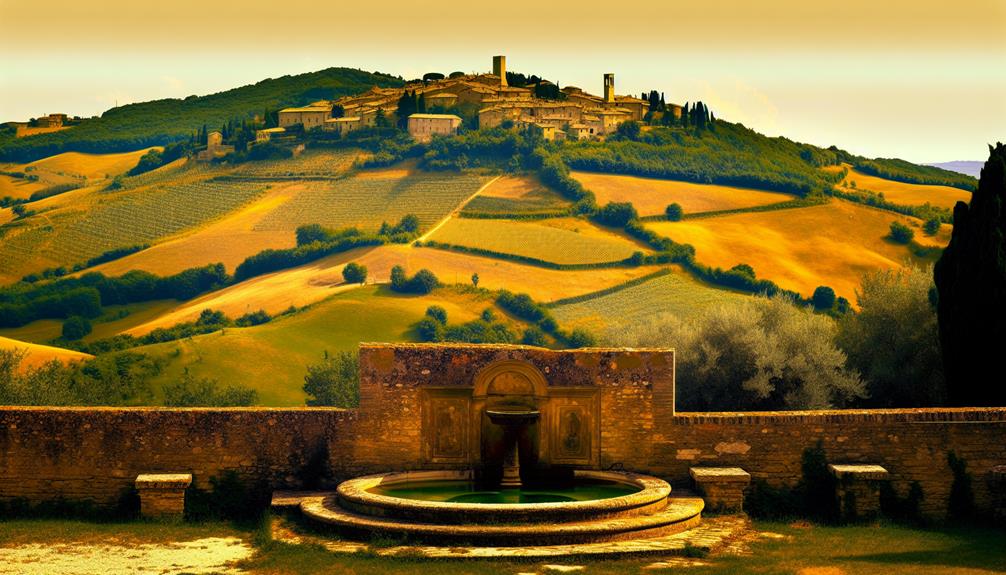Umbria is a treasure trove of cultural wonders, with its ancient towns, historic churches, and remarkable art that dates back centuries. From the masterpieces of Perugia to the frescoes of Assisi, the region offers a profound journey through Italy’s artistic and historical heritage. Our guide uncovers the must-visit sites that capture the essence of Umbria’s cultural legacy. For an authentic and comfortable stay, take a look at our Italian countryside villa rentals and make your cultural exploration even more memorable. Discover the soul of Umbria today!
You’re standing in the midst of Umbria’s picturesque landscape, surrounded by medieval hilltop towns that seem frozen in time. As you wander through their narrow streets and fortified walls, you can’t help but wonder what secrets lie hidden beneath the surface. The region’s rich cultural heritage, shaped by Etruscan and Roman civilizations, is waiting to be uncovered. You’ve caught glimpses of intricate frescoes and stone carvings, but what stories do they tell? The grand cathedrals and palaces, like the Basilica of San Francesco in Assisi, hold many more secrets – and you’re just starting to scratch the surface.

Medieval Hilltop Towns
Many of Umbria’s medieval hilltop towns still evoke the same sense of strategic stronghold and picturesque beauty that they did centuries ago. As you explore these towns, you’ll notice that they’re often perched on hilltops, a reflection of their defensive origins.
The narrow, winding streets and closely-packed houses were designed to provide protection from invaders and harsh weather conditions. You’ll see the remnants of ancient fortifications, including walls, towers, and gates, which now serve as a reminder of the region’s rich history.
The architecture of these towns is also remarkable. You’ll see a mix of medieval and Renaissance styles, with buildings made from local stone and terracotta.
The towns’ central piazzas are often surrounded by grand churches and civic buildings, which showcase the region’s artistic and cultural heritage. As you wander through these towns, you’ll get a glimpse into the daily lives of the people who lived there centuries ago.
The preservation of these medieval towns is a reflection of Umbria’s commitment to preserving its history and cultural identity. By exploring these towns, you’ll gain a deeper understanding of the region’s complex history and its continued influence on contemporary culture.
Etruscan and Roman Ruins
As you explore Umbria’s rich history, you’ll uncover remnants of the Etruscan and Roman civilizations that once flourished in the region.
The Etruscan civilization, which predates the Roman Empire, left behind numerous archaeological sites, including the ancient city of Orvieto. Here, you’ll find the Necropoli del Crocifisso del Tufo, a collection of underground tombs that date back to the 5th century BC. The intricate stone carvings and frescoes that adorn the tombs provide a glimpse into the lives of the Etruscan people.
Umbria was also an important region in the Roman Empire, and the city of Spoleto is home to several Roman ruins, including the Porta Venere and the Ponte delle Torri.
The Porta Venere, a well-preserved Roman gate, is one of the most impressive examples of Roman architecture in the region. The Ponte delle Torri, a medieval bridge built on Roman foundations, offers breathtaking views of the surrounding countryside.
As you explore these ruins, you’ll gain a deeper understanding of the history and culture of the region. These ancient structures are a monument to the ingenuity and craftsmanship of the Etruscan and Roman civilizations.
Renaissance Art and Architecture
Beyond the ancient Etruscan and Roman ruins lies a treasure trove of Renaissance art and architecture that showcases the region’s enduring influence on Italian culture. As you explore Umbria, you’ll discover an impressive array of Renaissance-era buildings, from grand cathedrals to intricately frescoed churches. The Basilica of San Francesco in Assisi, with its striking rose window and ornate stone carvings, is a masterpiece of Renaissance architecture.
You’ll also notice the distinct Umbrian style, characterized by clean lines, harmonious proportions, and a masterful use of local stone. The Palazzo dei Consoli in Gubbio, for example, features an imposing façade with ornate balconies and intricate carvings, epitomizing the region’s sophisticated Renaissance aesthetic.
As you investigate deeper into the region’s Renaissance heritage, you’ll uncover an array of frescoes and paintings by renowned artists, including Perugino, Pinturicchio, and Signorelli. Their works adorn the walls of churches and palaces, offering a glimpse into the region’s rich artistic legacy.